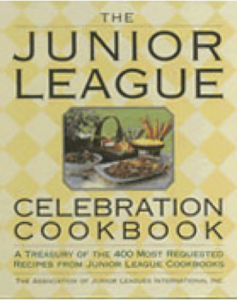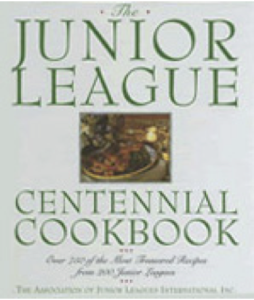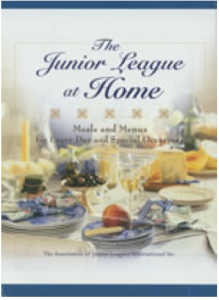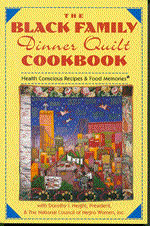“I have written some of my memoirs! Now I need your creativity to promote it freely!”
The late Dr. Dorothy I Height
Chair/President Emerita, National Council of Negro Women, Inc.
Trade Publishing
Cookbooks are Storybooks
Ellen Rolfes is the visionary behind the “Community Cookbook” trade publishing genre.
She understood that a cookbook could be far more than an instruction manual, rather a storybook about how a given community lives intimately together in a place and time.
The community cookbook reflect Ellen’s core message – that “the values, beliefs and traditions of a culture are preserved and passed on at the ‘meal table.’”
Cookbooks became storybooks to me in a rather unsuspected way. As a child, I suffered from severe asthma. Back then descent medicine did not exist, thus I would be sick for weeks at a time. One of my family’s home remedies was literally to carry me a few blocks up the street to my grandparents’ house for a long visit. There they would prop me up on pillows in large antique bed to help my breathing. I lay there so weak for days on end just daydreaming, playing with imaginary friends, and creating a whole new world.
One afternoon my grandfather came to my bedside with a gift; it was a small wicker basket filled with miniature, handmade toys – a man and woman fashioned from cloth, a wooden table, two painted chairs, a basket and a stone cooking pot. That gift ignited the spark of my powerful, nascent imagination as I began seeing the patterns and possibilities.
I started making up endless vignettes about life on my “stage” of fluffed up pillows where the couple prepared a meal together, ate at the tiny table and talked intimately. In that process I was making my own “meal memories” and discovering the power of storytelling around the table to create meaning in life. Little did I know at the time that a large part of my career was being molded as I was destined to be an “armchair cook!”
In life there are no accidents. I now see how my recurring childhood asthmatic debilitation was the driving catalyst that led me to take the community cookbook into uncharted waters as a storybook.
For me, cookbooks were the “keepers of the flame.” By using the traditional recipe presentation as the perfect framework, this book form could document the meal table as the cultural setting where we pass on our values, beliefs and traditions to the next generation. I later also discovered that the unique language of recipes was ingenious, and the implied humor was contagious! The voices of women contributors were trying to again be heard, and it excited me to see this feminine expression continue finding a creative venue through the community cookbook.
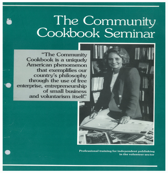 That was the spark that took me from being a cookbook committee volunteer to becoming a professional cookbook developer. I began training non-profits around the country through The Community Cookbook Seminar, teaching them how to create, produce and market their own community cookbooks as a fundraiser. As I traveled from coast to coast I discovered that this dazzlingly bright feminine energy was everywhere but contained on these volunteer committees. Back then women had few outlets for personal and career development, and these committee roles afforded venues where they could express themselves using the cookbook as a medium and ultimately develop their resumes to re-enter the job market.
That was the spark that took me from being a cookbook committee volunteer to becoming a professional cookbook developer. I began training non-profits around the country through The Community Cookbook Seminar, teaching them how to create, produce and market their own community cookbooks as a fundraiser. As I traveled from coast to coast I discovered that this dazzlingly bright feminine energy was everywhere but contained on these volunteer committees. Back then women had few outlets for personal and career development, and these committee roles afforded venues where they could express themselves using the cookbook as a medium and ultimately develop their resumes to re-enter the job market.
Time passed. I had grown to a point that I no longer wanted to be the “mid wife” to community cookbooks, but rather the “birth mother.” In this subtle shift was opportunity, as cookbooks had traditionally been only recipe collections without any internal conversation – really, just instruction manuals. But by going deeper into the essence of the book form, I saw the connection to the vignettes I’d created while propped up in that antique bed and the stories told by my elders during the muggy nights on boat docks. It all became clear to me – the community cookbook was the perfect social commentary to shed light on how people choose to live intimately with one another in a certain time and place.
That was the start of Ellen Rolfes Books, Inc., a book packaging company. I owe a huge debt of gratitude to John Boswell in New York City who taught me the business of developing and selling intellectual property to trade publishers and the Association of Junior Leagues International, Inc., my first collaborative publishing partner with these three titles.
My fateful meeting earlier with the late Dr. Dorothy Irene Height, Chair/President Emerita of the National Council of Negro Women , Inc. (NCNW) in Washington, DC had served as the next major steps of my journey. Working with Dr. Height and the NCNW, we developed a three-book series: The Black Family Reunion Cookbook, The Black Family Dinner Quilt Cookbook and Mother Africa’s Table.
As we talked over shared meals to find the “voice” of the titles, I typically looked for the subtle connection or patterns and possibilities that would pull everything together. One day it came to me during a lunch with the NCNW cookbook committee – a new, unique editorial technique that I was to use over and over again – that of “meal memories.” I recall spontaneously guiding those women deeply into the well of their being, bringing to the surface their own personal mealtime stories that were later woven into the editorial content. Such classic meal memories as “Lower Thirteen” recounts the formidable Mrs. Bethane, founder of the NCNW, who was asked by the conductor on a train,“Auntie, can you make good biscuits?” Dr. Height herself recalled the days as a member of the Civil Rights Movement’s “Big Six”, where she would attend a weekly planning breakfast with A. Phillip Randolph, Martin Luther King, Jr. and others. Dr. Height was technically the 7th member of the powerful group, but I remember asking her why wasn’t she included in the count? Being a woman, she explained, the men did not accept her as one of them! Countless other tender meal memories emerged such as “Aunt Cora Raised Me” or “Spiritual Vibrations” and infused this cookbook trilogy with authentic life. I soon discovered that stories centered around mealtime sustain the African-American culture, as I now know they do all cultures.
Through the years with NCNW, I conducted training sessions at their bi-annual conventions and was privileged to have had many private conversations at mealtime with their beloved, iconic Dr. Height. She and I talked honestly about racism, women and children’s issues, and the changing times. She recounted painful, intimate stories of her long experience as a Civil Rights activist. Through it all she revealed that we both agreed on an extremely important truth — that more profound and meaningful work could be accomplished at the dinner table than the conference table.
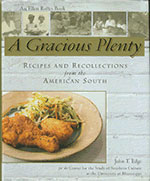 The “meal memory” technique continued to infuse my world of the community cookbook with new possibilities. A Gracious Plenty- Recipes – Recollections from the American South took me back to my own Mississippi taproot as I partnered with the Center for the Study of Southern Culture at the University of Mississippi. This wonderful title was nominated for the James Beard Award for its unique examination of the Deep South’s paradoxical relationship to food as a land of want and a land of plenty. The meal memories are vibrant – “B.B. King’s Sunday Feast” tells about when he was a sharecropper; Reynolds Price’s “Pleasure of Pimiento”– relishes the “peanut butter” of his childhood; and Damon Fowler’s “Dinner on the Grounds.” Wonderful essays in the cookbook such as “Pig Pickin’ and Politicking,” “Sweet & Sacred,” “A Southern Way of Caring,” and “It’s an Old Pot That Makes a Good Soup” clearly demonstrated the power of food to unite us all.
The “meal memory” technique continued to infuse my world of the community cookbook with new possibilities. A Gracious Plenty- Recipes – Recollections from the American South took me back to my own Mississippi taproot as I partnered with the Center for the Study of Southern Culture at the University of Mississippi. This wonderful title was nominated for the James Beard Award for its unique examination of the Deep South’s paradoxical relationship to food as a land of want and a land of plenty. The meal memories are vibrant – “B.B. King’s Sunday Feast” tells about when he was a sharecropper; Reynolds Price’s “Pleasure of Pimiento”– relishes the “peanut butter” of his childhood; and Damon Fowler’s “Dinner on the Grounds.” Wonderful essays in the cookbook such as “Pig Pickin’ and Politicking,” “Sweet & Sacred,” “A Southern Way of Caring,” and “It’s an Old Pot That Makes a Good Soup” clearly demonstrated the power of food to unite us all.
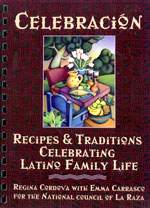 In CELBRACIðN, Recipes & Traditions Celebrating the Latino Family Life, created with the National Council of La Raza each recipe was introduced with a story that captured the emerging “latinization” of our country. In our desire as Americans to learn more about their culture, perhaps we witnessed in the cookbook how tightly knit the Hispanic culture was held together by the meal table. Food, for example, represents much more to the families than a way to nourish or quiet one’s hunger. It is a time to pass on language, folklore, and cultural legacies. Take for example the annotated recipes, “Mexican Sausage with Tequila” to quench a Sunday morning appetite, “Arroz con Gandules” to soothe a child yearning for the familiar Christmas dish of his native Puerto Rico, or the “Layered Coconut Cream Torte” that required hours of a Venezuelan grandmother’s loving time.
In CELBRACIðN, Recipes & Traditions Celebrating the Latino Family Life, created with the National Council of La Raza each recipe was introduced with a story that captured the emerging “latinization” of our country. In our desire as Americans to learn more about their culture, perhaps we witnessed in the cookbook how tightly knit the Hispanic culture was held together by the meal table. Food, for example, represents much more to the families than a way to nourish or quiet one’s hunger. It is a time to pass on language, folklore, and cultural legacies. Take for example the annotated recipes, “Mexican Sausage with Tequila” to quench a Sunday morning appetite, “Arroz con Gandules” to soothe a child yearning for the familiar Christmas dish of his native Puerto Rico, or the “Layered Coconut Cream Torte” that required hours of a Venezuelan grandmother’s loving time.
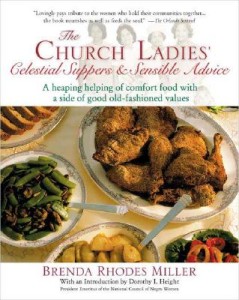 The Church Ladies’ Cookbooks took me on a rare adventure into a world I have never known – the powerful matriarchal culture of the Black church. The journey was the gift of my friend and author, Brenda Rhodes Miller, who partnered with me to develop The Church Ladies Divine Desserts and The Church Ladies Celestial Suppers. The essays and intimate stories are wisdom teachings that reflect these strong, steadfast women – titles such as “Idle Hands Are the Devil’s Tools,” “Mother Loved Sunday School,” “A Cooling Hand on a Fevered Brow,” “Let the Circle Be Unbroken,” “Aunt Shorty’s Pastor Meets B.B. King,” and “I Stand at the Door and Knock” are priceless.
The Church Ladies’ Cookbooks took me on a rare adventure into a world I have never known – the powerful matriarchal culture of the Black church. The journey was the gift of my friend and author, Brenda Rhodes Miller, who partnered with me to develop The Church Ladies Divine Desserts and The Church Ladies Celestial Suppers. The essays and intimate stories are wisdom teachings that reflect these strong, steadfast women – titles such as “Idle Hands Are the Devil’s Tools,” “Mother Loved Sunday School,” “A Cooling Hand on a Fevered Brow,” “Let the Circle Be Unbroken,” “Aunt Shorty’s Pastor Meets B.B. King,” and “I Stand at the Door and Knock” are priceless.
 The vintage black and white photography throughout the cookbooks depicts the leadership of “mother board” dressed in white dresses, gloves and shoes or other “church ladies” who show the fashion extravaganzas that are popular in many churches.
The vintage black and white photography throughout the cookbooks depicts the leadership of “mother board” dressed in white dresses, gloves and shoes or other “church ladies” who show the fashion extravaganzas that are popular in many churches.
The timeless recipes prepared for church receptions and rituals such as weddings, holidays or repasts stand alone as some of the most culturally sensitive I have ever known. They have been passed down for generations and rarely published as guarded treasures in the African-American community. Among the very best culinary creations in The Church Ladies’ Divine Desserts are “Creole Charlotte Russe,” “Prune Whip,” “Ambrosia” and “Tangerine Cake.” Heaven on a plate!
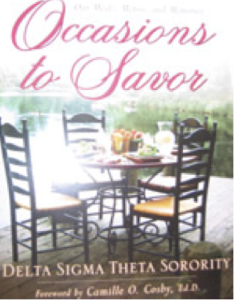 OCCASIONS TO SAVOR–Our Meals, Menus and Memories was an entirely different journey into the Black female experience. This cookbook captured the stories of the “sorors,” members of the powerful international sorority, Delta Sigma Theta, documenting how these accomplished women used special occasions centered around elegant meals to build a power base of over 200,000 women and supported by a network of high-profile leaders including Dr. Camille Cosby, Dr. Jonnetta Cole, Ruby Dee, the honorable late Barbara Jordan, Julianne Malveaux, Alexis Herman, Harolyn Blackwell, the late Dr. Mary McLeod Bethune and certainly their tenth “grand soror,” the late Dr. Dorothy Height.
OCCASIONS TO SAVOR–Our Meals, Menus and Memories was an entirely different journey into the Black female experience. This cookbook captured the stories of the “sorors,” members of the powerful international sorority, Delta Sigma Theta, documenting how these accomplished women used special occasions centered around elegant meals to build a power base of over 200,000 women and supported by a network of high-profile leaders including Dr. Camille Cosby, Dr. Jonnetta Cole, Ruby Dee, the honorable late Barbara Jordan, Julianne Malveaux, Alexis Herman, Harolyn Blackwell, the late Dr. Mary McLeod Bethune and certainly their tenth “grand soror,” the late Dr. Dorothy Height.
Throughout their history, African American women, and Deltas sisters in particular, used ingenuity to survive and thrive. Although their ancestors may have been forced to “grow the fruit but eat the rind,” they transformed those rinds into nutritious and delicious dishes in this cookbook and all along, just like Dr. Mary McLeod Bethune’s legacy, they were harnessing power to address society’s unfinished business.
The color photography is a celebration of sisterhood, documenting how African-blooded women globally and historically, prepared foods in communal settings while sharing experiences, information and guidance. Occasions to Savor reveals their collective story and their individual meal memories formed in uniquely African-American culinary events with evocative names such as Jabberwocks, Step Shows, Delteen Teas, Juneteenth Backyard Picnics and Crimson & Cream Balls.
While being an honorary sorority member wasn’t a possibility, I was surprised at their national convention in Las Vegas where we launched the cookbook. Their president, Dr. Gwendolyn Boyd, called me up from the audience and dubbed me as their “Ya Ya Sister” because the storyline of the movie of that title and its Southern characters reminded them of me! Many Deltas still call me Ya Ya.
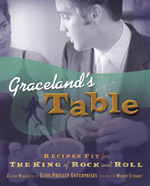 There came the extraordinary birthing of GRACELAND’S TABLE- Recipes Fit for the King of Rock and Roll with Elvis Presley Enterprises. I knew that Elvis was a man who never strayed from home cooking, no matter where his fame took him. The title’s editorial theme was built around interviewing Elvis’s global fan base who contributed their favorite Elvis stories and their own recipes created as homage to the king. How about “Burning Love Chicken Enchilada Casserole,” “Big Boss Man Italian Sausage Bombers,” “Hound Dog Hush Puppies,” or “Suspicious Minds Clam Dip?” Like all good meal memories, these stories made the title sell because they were real to the fans and represented an expression of their true affection for the “King.”
There came the extraordinary birthing of GRACELAND’S TABLE- Recipes Fit for the King of Rock and Roll with Elvis Presley Enterprises. I knew that Elvis was a man who never strayed from home cooking, no matter where his fame took him. The title’s editorial theme was built around interviewing Elvis’s global fan base who contributed their favorite Elvis stories and their own recipes created as homage to the king. How about “Burning Love Chicken Enchilada Casserole,” “Big Boss Man Italian Sausage Bombers,” “Hound Dog Hush Puppies,” or “Suspicious Minds Clam Dip?” Like all good meal memories, these stories made the title sell because they were real to the fans and represented an expression of their true affection for the “King.”
This cookbook project was incredible fun – from talking with country music star Marty Stewart, as he developed the foreward, writing my own introduction from the perspective of being a lifelong Elvis fan, then working with our team – the food stylist, photographer, editor and countless others on site at Graceland. We had the mansion all to ourselves for an entire winter day to do the photo shoots. We paddled all over Graceland in our stocking feet as we staged meal memories in the jungle room, the pool room, the TV room, the serene white and sky-blue living room, the 24/7 kitchen and the music room with the baby grand piano. Elvis lives (through this cookbook)!
 THE BREAD OF LIFE – A Cookbook for Body & Soul with the National Episcopal Church Women was a different, deeply moving experience. Here we explore the message of the Eucharist – the breaking of bread – through meal memories. Scriptural stories were woven throughout the book – stories that took on new meaning when re-framed as meal memories – the feast of Deuteronomy’s Promised Land, the manna story in Exodus, and ultimately the stories of Jesus, the traveling rabbi who gathered people together enjoying hospitality and his “teaching tales” – Mary at the Master Teacher’s feet while Martha was dutifully preparing the meal, the Loaves and the Fishes, the Wedding Feast, the Last Supper and more.
THE BREAD OF LIFE – A Cookbook for Body & Soul with the National Episcopal Church Women was a different, deeply moving experience. Here we explore the message of the Eucharist – the breaking of bread – through meal memories. Scriptural stories were woven throughout the book – stories that took on new meaning when re-framed as meal memories – the feast of Deuteronomy’s Promised Land, the manna story in Exodus, and ultimately the stories of Jesus, the traveling rabbi who gathered people together enjoying hospitality and his “teaching tales” – Mary at the Master Teacher’s feet while Martha was dutifully preparing the meal, the Loaves and the Fishes, the Wedding Feast, the Last Supper and more.
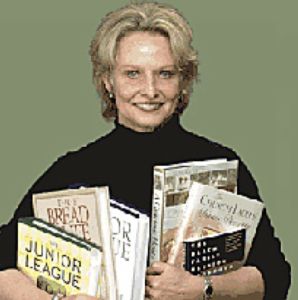 Throughout my journey with cookbooks, I have discovered that each day the young and old, the rich and poor, the strong and weak, the good and the bad, all gather still at the table to share a meal. More than just an essential to sustaining life, food is a touchstone that binds people together in a timeless ritual. Bringing a good thought to the table is as important as bringing good food to the table. While we eat in community, we speak about the events of the day, reminisce with childhood memories, proselytize our faith, review current events, teach social responsibility (and table manners), face our individual and collective fears, discover one another’s truths, and reveal our hearts about the visions we share for tomorrow.
Throughout my journey with cookbooks, I have discovered that each day the young and old, the rich and poor, the strong and weak, the good and the bad, all gather still at the table to share a meal. More than just an essential to sustaining life, food is a touchstone that binds people together in a timeless ritual. Bringing a good thought to the table is as important as bringing good food to the table. While we eat in community, we speak about the events of the day, reminisce with childhood memories, proselytize our faith, review current events, teach social responsibility (and table manners), face our individual and collective fears, discover one another’s truths, and reveal our hearts about the visions we share for tomorrow.
When two or more are gathered, we participate in something far greater than ourselves. And if we are truly awake, we give thanks for the celebration of life through meal memories because these times afford us a sacred connection with one another.
In conclusion, the following powerful poem, “Perhaps the World Ends Here” captures for me the “why” of the community cookbook. This under-celebrated book form quietly documents the meaning of the “meal table” by presenting the recipes and stories that are preserved and passed on through “meal memories.” And for this contribution to our world, we must give thanks.
Perhaps the World Ends Here
by Joy Harjo
The world begins at a kitchen table. No matter what, we must eat to live.
The gifts of earth are brought and prepared, set on the table so it has been since creation, and it will go on.
We chase chickens or dogs away from it.
Babies teethe at the corners. They scrape their knees under it.
It is here that children are given instructions on what it means to be human. We make men at it, we make women.
At this table we gossip, recall enemies and the ghosts of lovers.
Our dreams drink coffee with us as they put their arms around our children. They laugh with us at our poor falling-down selves and as we put ourselves back together once again at the table.
This table has been a house in the rain, an umbrella in the sun.
Wars have begun and ended at this table. It is a place to hide in the shadow of terror. A place to celebrate the terrible victory.
We have given birth on this table, and have prepared our parents for burial here.
At this table we sing with joy, with sorrow. We pray of suffering and remorse.
We give thanks.
Perhaps the world will end at the kitchen table, while we are laughing and crying,
eating of the last sweet bite.

